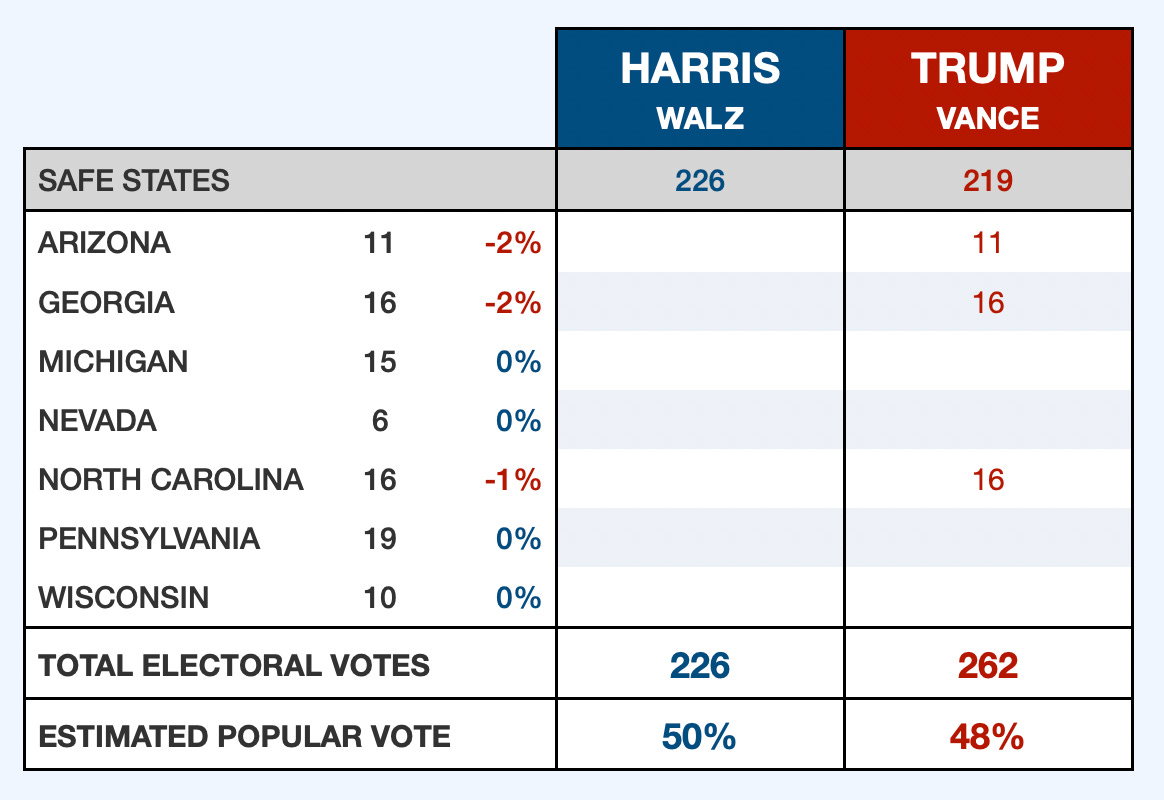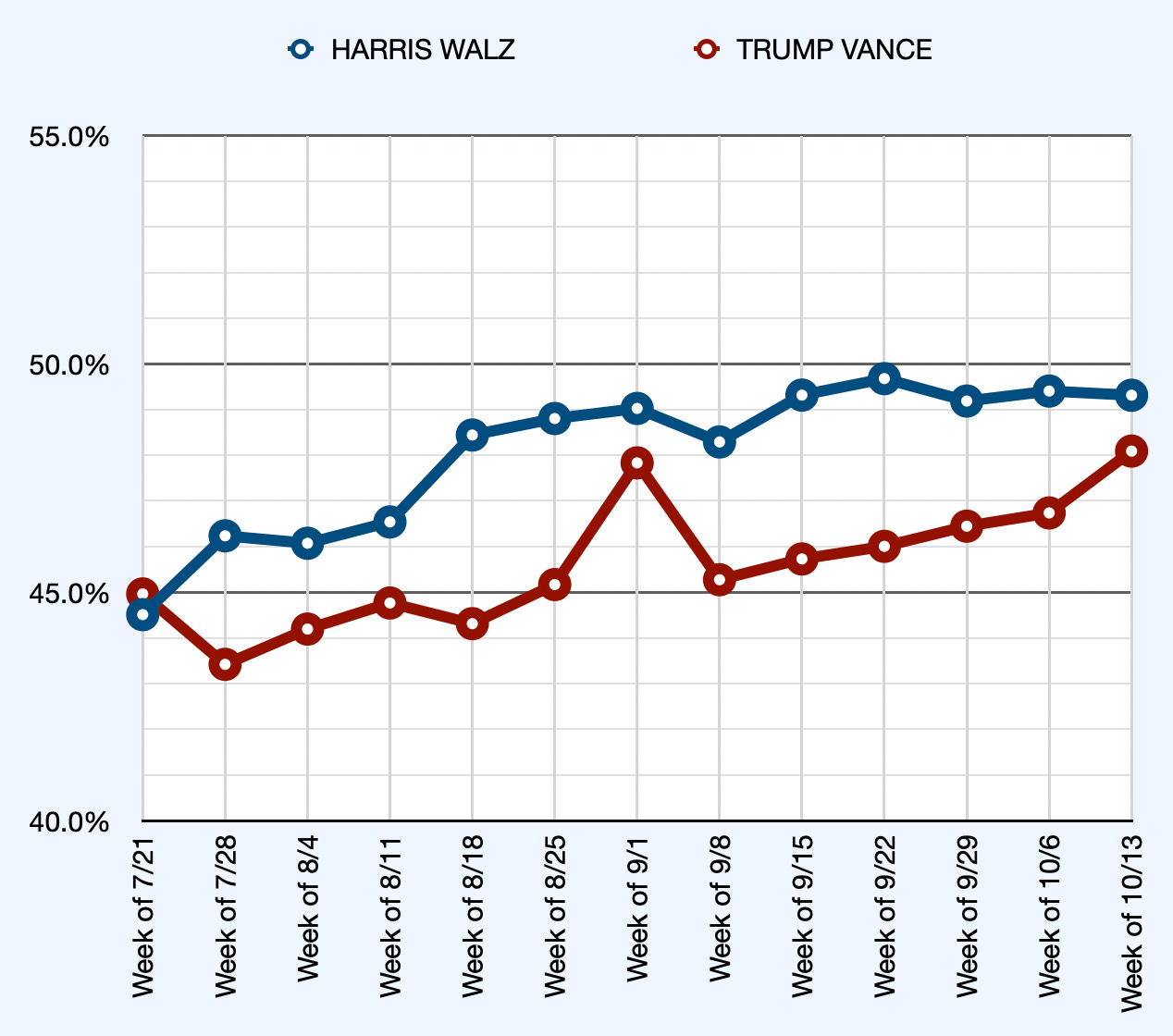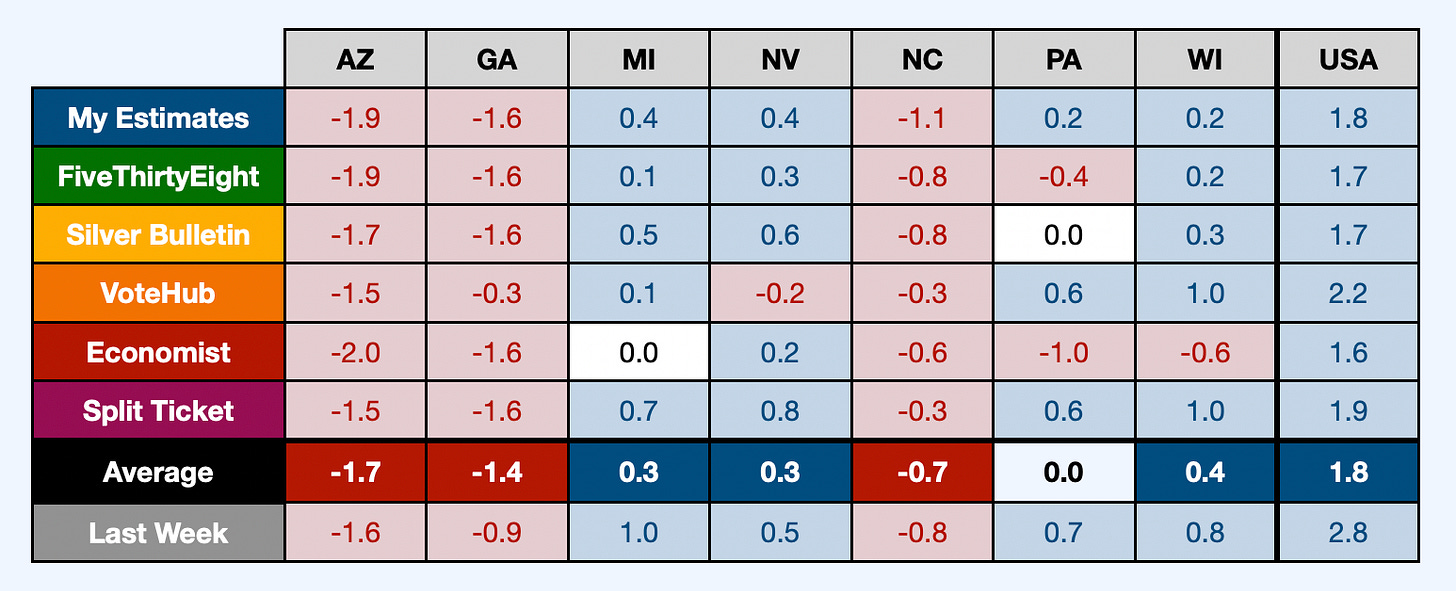State of the 2024 Race as of Oct. 21
No candidate has 270 Electoral Votes as the national margin tightens
Thank you for reading my analysis of current polling in the 2024 Presidential race. This will be updated every Monday evening until the election. If you have friends who you think would be interested in receiving these updates, please share this with them! There is no cost to subscribe to these updates.
Last week’s update saw Wisconsin and Nevada tighten into ties (with no candidate leading by even 1% of the vote) due to Trump-leaning polling coming in at the state level. This week, Harris saw her state-level polling improve in most of the critical states… but her margin in national polling slipped by around 1 point. Because national polling is factored into my state by state estimated margins, this nudged Michigan and Pennsylvania into “tied” status. Across the board, Harris now leads in those four key swing states by less than 0.5% in my polling averages. She does, however, still lead, which is better than trailing.
Are Republican-backing pollsters tilting the averages towards Trump? This is a question that has popped up a lot in recent days. Every pollster has a “house effect,” due to how they construct their likely voter screen or weight their sample. There are significantly more Republican pollsters releasing data as we approach Election Day compared to Democratic-aligned pollsters. FiveThirtyEight did an analysis to determine if these polls were messing with their averages, and found that the Republican pollsters moved the averages about 0.4 percent towards Trump (though more in Pennsylvania). If you want to mentally adjust averages you see to account for Republicans “flooding the zone,” then just presume that Harris is doing about half a point better in reality than she appears to be doing in averages. But don’t take too much solace in that: we still need to get out and win this thing.
The Presidential race is tied. Either candidate can easily win. This isn’t reason to despair. Given the national mood, the worldwide trend against incumbents, and Biden’s approval ratings, it’s a sign of great strength that Harris has as good (or maybe slightly better) of a chance of winning as Trump. But she can’t win this election on her own. We all need to help. Volunteer this week for Kamala Harris!
If we outwork the Republicans, and we can, then we will win.
Road to 270 Electoral Votes
Neither candidate holds measurable leads in enough states to win if the election were held today based on my polling averages. Harris has a less than 0.5% lead in Michigan, Pennsylvania, Wisconsin, and Nevada (which in last week’s averages tilted ever-so-slightly towards Trump). The methodology used to calculate these averages is described towards the end of this post.
🟣 Neither candidate appears to lead in Michigan (15 electoral votes), Nevada (6 electoral votes), Pennsylvania (19 electoral votes) and Wisconsin (10 electoral votes). That is a shift of 1 point away from Harris in Michigan and Pennsylvania in the last week, and a shift of around half a point towards Harris in Nevada.
🔴 Trump appears to lead by around 1 point in North Carolina (16 electoral votes).
🔴 Trump appears to lead by around 2 points in Georgia (16 electoral votes) and Arizona (11 electoral votes). That is a shift of 1 point towards Trump in Georgia in the last week.
In the national popular vote, Harris appears to lead by around 2 points. That is a shift of 1 point towards Trump nationally in the last week.
The present tipping point state is Pennsylvania, and the current differential between the tipping point margin and the national popular vote is 1.7 points, a decrease of 1 point since last week. Trump gaining nationally but not really gaining much in the swing states cut deeply into the Electoral College’s Republican tilt.
A uniform standard polling error towards either candidate would lead to them sweeping all seven swing states. While they feel very different a 1 point for Trump or a 1 point lead for Harris doesn’t really mean much in terms of who will actually win. This is the closest Presidential race in decades.
Polling in the Past Week
Last week was a tough week of Harris in the statewide polling. This week was a somewhat tough week in the national polling. A lot of national polls were released this week: 15, though two of those were from pollsters who released two surveys.
Amongst the highest-quality pollsters, a Marist poll showed a 5 point Harris lead, while Marquette showed the race a tie and Atlas Intel reported a 3 point lead for Trump. A YouGov poll for The Economist came in with a 4 point margin for Harris, and both Emerson and Suffolk Universities showed Harris leading by 1 point.
Three other high quality pollsters came in with divergent numbers: a 2 point lead for Trump in a Beacon and Shaw poll for Fox News and a 3 point edge for Harris in both an Ipsos survey done for Reuters and a Fairleigh Dickinson poll.
Rounding out the weeks polls were surveys from RMG Research (Harris up 1), Quantus (Harris up 1), TIPP Insights (Harris up 2 on October 17, Trump up 1 on October 20), and Harris X (Harris up 2 in two surveys for different clients).
In most of these surveys, Harris’s number was very similar to what has been seen in polls in the last few weeks, while Trump’s number was a marked improvement. This could represent more Trump voters passing the “likely voter” screen, or perhaps Trump-reluctant undecideds coming home to the Republican nominee as the race closes.
🔵 Harris held a lead of 1.2 points in a weighted average of all national polls completed in the week of October 13, compared to a 2.7 point advantaged in surveys completed in both of the two preceding weeks.
Harris got better numbers in swing state polling the week of December 13 than she did the week before, which, as we all know, is ultimately more important. Weighted averages week over week shifted to Harris by 2.8 points in Nevada, 1.6 points in Wisconsin, and 1.3 points in Michigan, but slipped by 0.4 points in Pennsylvania.
In Nevada, five new polls were released last week, and 🔵 Harris led by 0.9 points in the weighted average, compared to a 1.9 point Trump lead in surveys released the week before.
In Wisconsin, six new polls were released last week, and 🔵 Harris led by 0.9 points in the weighted average of them, compared to a 0.7 point Trump lead in surveys released the week before.
In Michigan, eight new polls were released last week, and 🔵 Harris led by 0.6 points in the weighted average of them, compared to a 0.7 point Trump lead in surveys released the week before.
In Pennsylvania, six new polls were released last week, and 🔵 Harris led by 0.1 points in the weighted average of them, compared to 0.5 point Harris lead in surveys released the week before.
In North Carolina, seven new polls were released last week, and 🔴 Trump led by 0.1 points in the weighted average of them, compared to a 0.4 point Trump lead in surveys released the week before.
In Georgia, eight new polls were released last week, and 🔴 Trump led by 1.1 points in the weighted average of them, compared to a 0.9 point Trump lead in surveys released the week before.
In Arizona, six new polls were released last week, and 🔴 Trump led by 1.5 points in the weighted average of them, compared to a 2.3 point Trump lead in surveys released the week before.
Comparison to Other Aggregators
Below is a table that compares my current projected margin in each of the seven swing states with that of other polling aggregators. Some of these websites also publish forecasts of the eventual November 5 results, but what I am listing here are their estimated margins of where the polls stand in each state today. The row at the bottom is the previous week’s average in each state, to provide a sense of how the averages of these aggregators have changed.
For the first time, there are major divergences in these polling averages. Nate Silver has Pennsylvania tied, while The Economist has swung hard towards Trump, indicating that their averages are probably more sensitive to shifts in more recent polling. Pennsylvania is tied in the average of averages right now.
If any of these averages were accurate down to a tenth of a point (they are not), then Harris would win with 276 electoral votes in my average and Split Ticket’s average. Harris would win with exactly 270 electoral votes in VoteHub’s average. It would all hinge on coin-flip Pennsylvania in Nate Silver’s average. Trump would win with 281 electoral votes in FiveThirtyEight’s average. Trump would win with at least 291 electoral votes in The Economist’s average.
Which, again, is to say that this thing is riding the knife’s edge and can go either way. So get out there and volunteer this week for Kamala Harris!
Methodology
The polling numbers discussed above are weighted, adjusted, and blended averages based on pretty much every poll released since Kamala Harris became the presumptive Democratic nominee in late July.
To produce these averages I take the following steps:
I collect polls from Twitter, aggregators and news websites. In cases when pollsters release more than one survey at the same time, I preference the head to head Harris versus Trump polls over the broader field polls (because I believe that polling greatly overstates third party vote shares) and likely voter surveys over registered voter surveys. I do not include “all adult” polls.
I weight the polls by pollster quality and time since completion. For pollster quality, I used the grades from FiveThirtyEight and Silver Bulletin translated into a 0.0 to 1.0 value. Pollsters with no such ranking are still included, but with a fairly low weight. Likely voter surveys are given 10% more weight than a registered voter survey from the same pollster would be. The weight given to a poll falls every seven days after its completion, to preference newer data over older data, and is zeroed out six weeks after the poll came out of the field. I do not adjust the weight given to a survey based on sample size.
I then adjust those weighted averages to split the undecideds and set the projected third party share of the vote at around 2 percent. This completes the process for creating my estimated national popular vote, but to create a final estimated vote in each state, there’s one more step.
I then take the margin in my estimated national popular vote, and combine it with a weighted average of the differential between each swing state/district’s 2016 and 2020 results and the national 2016 and 2020 results. This gives me an estimate of what the margin in each swing state/district would be based just on historical patterns and my estimated national popular vote margin. I then combine these regressions with the weighted, adjusted average for each state/district at a 20% to 80% weight, giving me a blended number and a final estimated vote in each swing state/district. In cases where there a very few, or only very old, polls in a specific state or district, I increase the weight of regression based on national polling.
While others might quibble with one part or another of this methodology, I’m comfortable with it. It’s my best attempt to take the data available and use it to create a fair estimate of the present state of the presidential campaign without my partisan preferences influencing my analysis.
If you have a significant problem with any of the steps above, please just accept that I’m not going to change my process at this point. If you want to do your own analysis, you almost certainly have Microsoft Excel or Apple Numbers (which is what I use) on your computer. Take a crack at it — math is fun!
Kamala Harris for President
While the point of these averages is to try to create an estimate of where the presidential race now stands in a data-based and impartial manner, I am not impartial. I don’t think any of us should be.
Kamala Harris is the right choice for President of the United States. She has been an excellent Vice President. She has cast tie breaking votes on landmark legislation such as the Inflation Reduction Act. She is running on a platform built around addressing real challenges facing the American people. She has plans to address prices and the cost of living. She has plans to address our nation’s critical housing shortage. She has plans to make it easier for new parents to afford the raise a family, for seniors to afford the prescription drugs we need, for young people to afford college. She supports fully restoring a woman’s right to choose across our nation, and will stand up against the radical right-wing agenda embodied by Project 2025, which is a direct threat to the freedoms and civil liberties Americans hold dear. She will stand up for our allies and democracy at home and abroad. She will not abandon Ukraine or NATO. She will work to build an economy of opportunity, one where we tackle climate change by embracing new technologies and creating energy abundance, one where it’s easier to start a business, one where everyone has a fair shot to achieve their dreams.
Donald Trump lost the 2020 election fair and square, and responded to that fact by whipping a mob into a frenzy and sitting back and doing nothing while they stormed the United States Capitol. You probably watched this attack on our nation on your television. I got to experience it firsthand as I hid in a secure room with my boss while the heart of American democracy was defiled. This was the climactic moment of a terrible presidency that divided our nation, that diminished our standing in the world, that packed our courts with theocrats who have used their power to undermine the rights of women, people of color, and LGBTQ people. Four years ago, 81 million Americans voted to fire Trump. Today, he’s surrounding himself with anti-vaccine conspiracy nuts, anti-gay activists who coddle dictators like Assad and Putin, and fanatics who proudly spread divisive and dangerous lies.
Kamala Harris has spent her life working for a better America as a prosecutor, a Senator, and Vice President. She’s an inspiring American story.
Donald Trump has spent his entire life nursing grievances and caring only about himself. He embodies everything our parents told us not to be when we grow up.
Vote for Kamala Harris on or before November 5, and if you can, please contribute to her campaign.
Local Politics Matter, Too!
And while I have your attention, I feel compelled to mention that I’m running for re-election on the Democratic ticket for Alexandria City Council this November. Over the three years that I have been a member of the City Council, I have worked to address our city’s affordable housing crisis, to do our part in the fight against climate change, to improve public safety by supporting our first responders, to support our young people by increasing funding for our schools and our senior citizens on fixed incomes by reducing their property taxes. I’ve also led the Council in standing up for Alexandria’s values by defending our abortion clinics in the wake of Dobbs and supporting our schools as they stood up to Governor Youngkin’s attacks on trans students.
I’m proud of my record in Alexandria, and of our city’s role in keeping Virginia blue. If you’d like to contribute to help me, and my fellow Democratic nominees, win in November and turn out the vote for Kamala Harris and Time Kaine, you can do so here.





Today’s Real clear politics